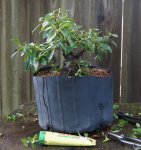No he didn't if you read a few post above the last one. Those new ones are just brand new which am sure he will wire once they extend but not lignified.
Well, he posted on January 5th that he had just wired it. There were no new shoots then! Those were lignified branches. Very brittle.
His latest picture shows some wire on lignified branches. I can't tell if that was wire from the January 5 application that's still on, or if it has been freshly applied.
What I DO see are fresh green shoots, none of which have been wired. Some of these new shoots have already been shortened.
The technique I recommend is to NOT shorten the new shoots yet, but instead wire them into place. If there are any downward leaves on the stem after wiring, pull those off. Put in movement close to the base of each wired branch, up and down, side to side.
That wire should stay on about 6 weeks, maybe less, until it begins to cut in. THEN remove wire, and cut back.
@Shima, are saying to lay two wires next to each other? Or wire "double helix" style? Double helix is two wires running up the branch, parallel, but not touching each other. That method CAN help reduce breaking as there's more places where the wire can be on the outside of the curve, supporting the branch. The angle the wires are placed are still the 45 degree angle. You want to avoid wrapping wire in a tight spiral, like a spring. Wire has little holding strength when coiled like a spring.
MarkyScott showed some "double helix" wiring on one of his threads on maples. Sorry, I don't remember which one. It is a valid way of wiring, especially for varieties with brittle branches. It does not look as "pretty" as two wires placed side by side, and sometimes it can look as if the branch is overwired. But it's safer.

















